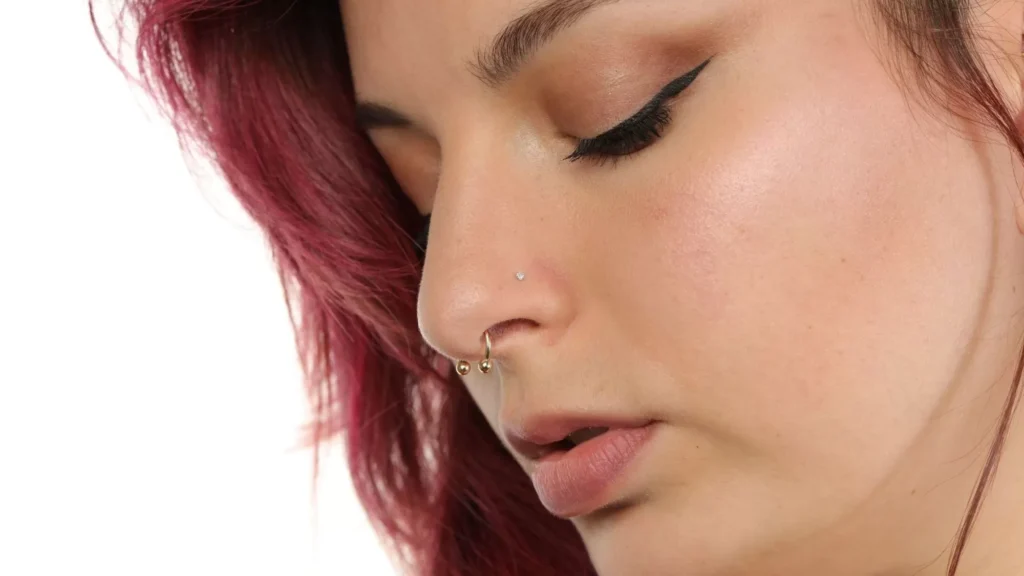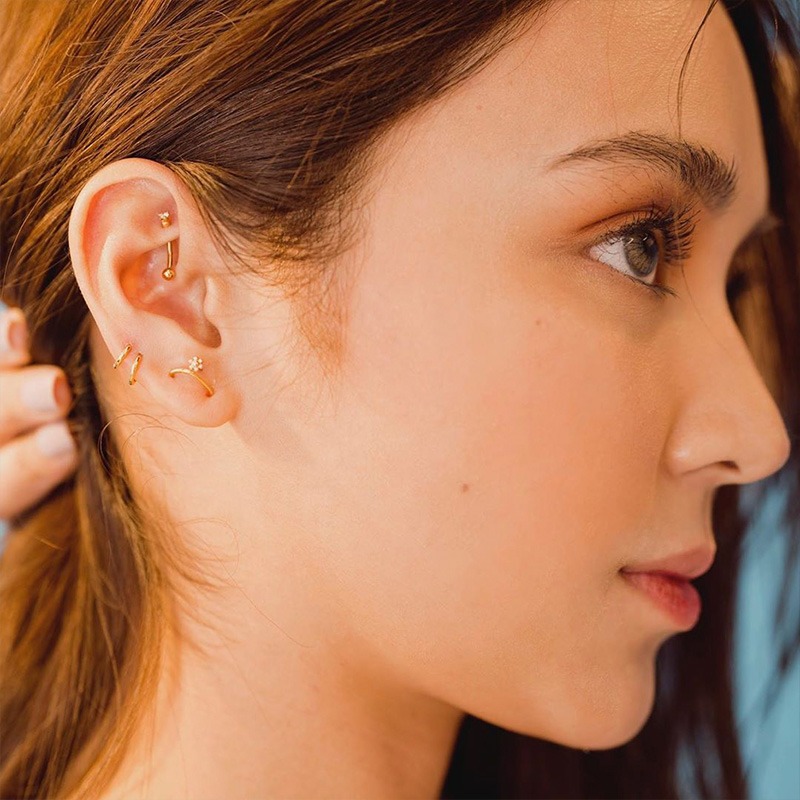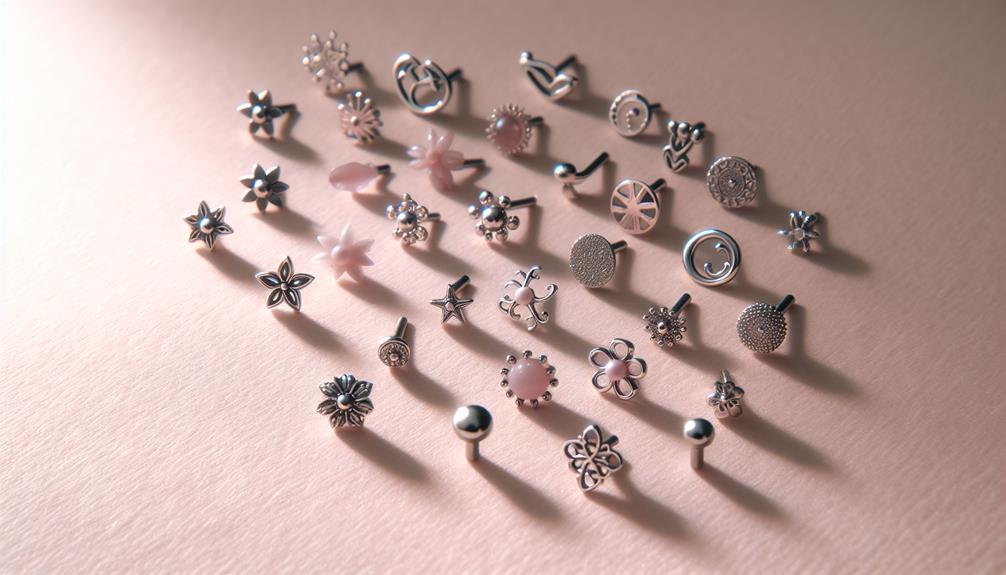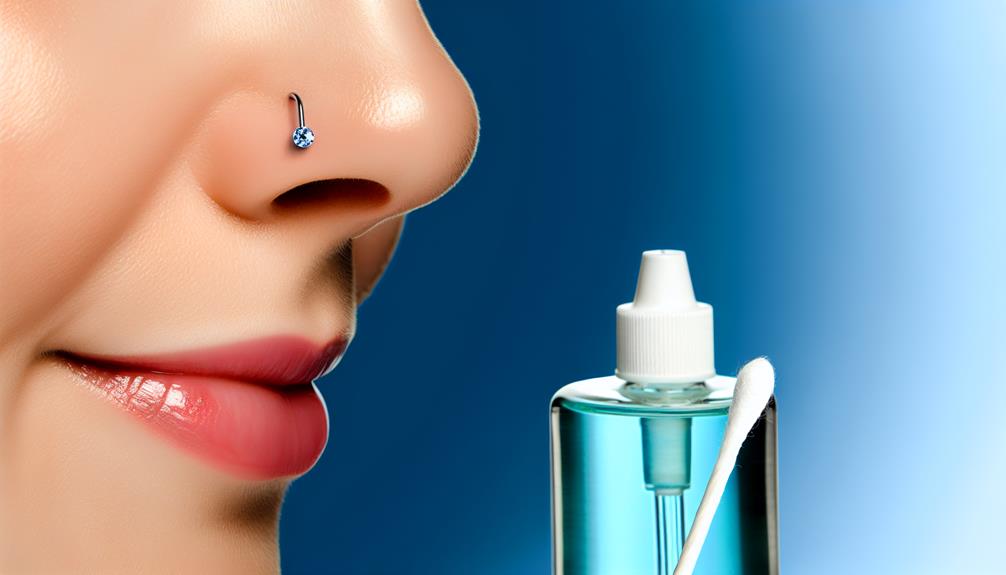Overview of ear piercing and common issues that can occur
Ear piercing is a popular form of body modification where a hole is created in the earlobe or the cartilage of the ear to insert jewelry. While ear piercing is generally safe and commonly practiced, there are some common issues that can occur during and after the piercing process. It is important to be aware of these potential problems to ensure a positive and safe experience.
Potential issues during ear piercing
– Infection: One of the common concerns during ear piercing is the risk of infection. If the equipment used for piercing is not properly sterilized, it can introduce bacteria into the piercing site, causing an infection. It is important to choose a reputable piercer who follows strict hygiene protocols to minimize this risk.
- Allergic reactions: Some individuals may have allergies to certain metals used in ear jewelry, such as nickel. This can cause an allergic reaction, leading to itching, redness, and swelling. It is recommended to choose hypoallergenic materials or consult with a professional piercer to avoid this issue.
- Pain and discomfort: Ear piercing can cause some level of pain and discomfort during the process. The sensation can vary depending on the individual’s pain tolerance and the area being pierced. It is essential to communicate any discomfort to the piercer, who can adjust the technique or provide appropriate aftercare instructions.
Common issues after ear piercing
– Keloids and scarring: Keloids are raised scars that can form around the piercing site. Some individuals are more prone to developing keloids, especially in cartilage piercings. Proper aftercare, such as cleaning the piercing site regularly and avoiding excessive touching, can help minimize the risk of scarring.
- Inflammation and swelling: It is normal to experience some inflammation and swelling after ear piercing. However, if the swelling becomes excessive or is accompanied by severe pain, redness, or discharge, it could be a sign of infection and should be addressed by a healthcare professional.
- Migration and rejection: In some cases, the body may reject the piercing, causing it to migrate or be pushed out. This can happen if the piercing is not placed correctly or if the body does not tolerate the jewelry. If migration or rejection occurs, it is best to consult with a professional piercer or healthcare provider.
It is important to note that these potential issues are not guaranteed to occur and can be minimized by choosing a reputable piercer, following proper aftercare instructions, and being mindful of any signs of infection or complications.

Understanding the Healing Process
Explanation of how ear piercings heal and why bleeding may occur
After getting an ear piercing, it is important to understand the healing process to ensure proper care and prevent any complications. Here is an overview of how ear piercings heal and why bleeding may occur:
During the healing process, the body works to close the wound created by the piercing. The initial healing stage typically lasts for 6-8 weeks, during which the pierced area may be red, tender, and slightly swollen. It is important to keep the pierced area clean and follow the aftercare instructions provided by the piercer.
Bleeding is a common occurrence immediately after getting a piercing. This is because the needle used to create the hole can cause small blood vessels to rupture, resulting in bleeding. It is normal to experience some bleeding during and immediately after the piercing process. However, if the bleeding continues for an extended period or if there is excessive bleeding, it is important to seek medical attention as it may indicate an issue or complication.
To prevent excessive bleeding and promote proper healing, it is recommended to avoid touching or twisting the jewelry, as this can disturb the forming blood clot and cause more bleeding. It is also important to avoid activities that may irritate or bump the pierced area, as this can also lead to bleeding.
Additionally, proper aftercare is crucial to avoid infection and promote healing. This includes cleaning the pierced area with a saline solution or an antimicrobial solution recommended by the piercer. It is important to follow the aftercare instructions provided and avoid using alcohol, hydrogen peroxide, or other harsh products as they can irritate the piercing.
So, understanding the healing process of ear piercings and why bleeding may occur can help individuals take proper care of their piercings and prevent any complications. By following the aftercare instructions provided by a reputable piercer and seeking medical attention if needed, individuals can ensure a successful healing process and enjoy their new ear piercings.
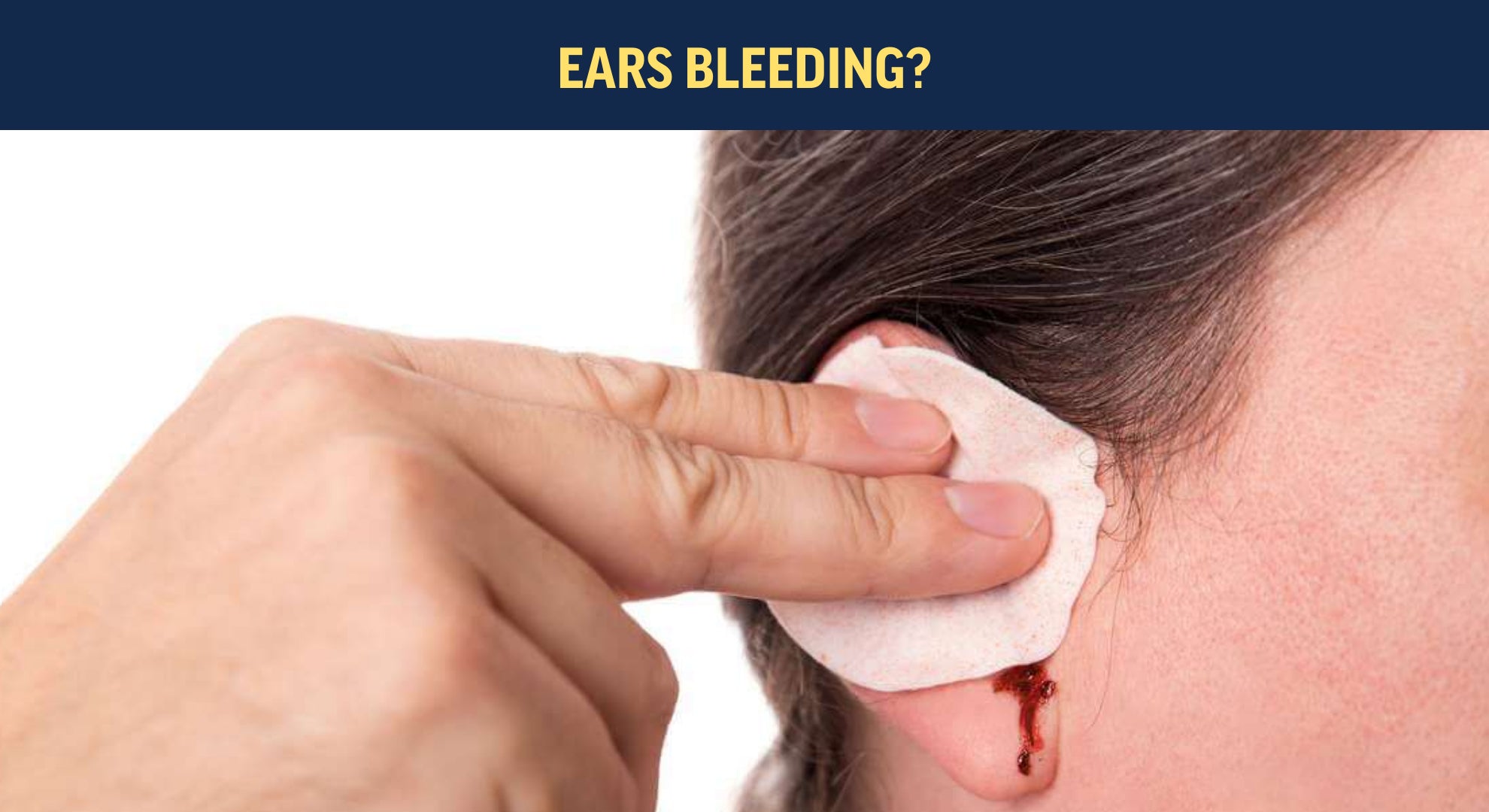
Possible Causes of Bleeding
Discussion of potential reasons for bleeding after years of having an ear piercing
Even years after getting an ear piercing, some individuals may experience occasional bleeding from the pierced area. While this can be concerning, there are several possible causes to consider:
- Injury or trauma: Sometimes, accidental injuries or trauma to the pierced area can cause bleeding. This can happen if the piercing is caught on clothing or jewelry, or if the ear is bumped or hit. It is important to be mindful of the pierced area and take precautions to avoid such incidents.
- Allergic reaction: In some cases, an allergic reaction to the jewelry can cause irritation, redness, and bleeding. This is more likely to occur if the individual has a known sensitivity to certain metals, such as nickel. If you suspect an allergic reaction, it is advisable to switch to hypoallergenic jewelry or consult with a professional piercer.
- Infection: In rare cases, a persistent or recurring infection can lead to bleeding. Signs of infection include increased redness, swelling, pain, and discharge. If you suspect an infection, it is important to seek medical attention promptly to prevent further complications.
In most cases, occasional bleeding from an ear piercing that has been healed for years is not a cause for major concern. However, it is recommended to observe the frequency and severity of the bleeding. If the bleeding becomes frequent, severe, or is accompanied by other symptoms, it is advisable to consult with a healthcare professional.
When experiencing bleeding from a healed ear piercing, it is crucial to maintain good aftercare practices. Keep the pierced area clean and dry, and avoid irritating or disturbing the jewelry. If the bleeding persists or worsens, it is important to seek medical attention to rule out any underlying issues.
Overall, understanding the possible causes of bleeding after years of having an ear piercing can help individuals take appropriate actions and ensure the continued health and well-being of their piercings. By staying vigilant and seeking professional advice when necessary, individuals can maintain the longevity and appearance of their beloved ear piercings.

Irritation and Infection
Explanation of how irritation and infection can lead to bleeding
When it comes to occasional bleeding from a healed ear piercing, two common causes to consider are irritation and infection. These factors can lead to bleeding even after years of having an ear piercing:
- Irritation: Sometimes, the jewelry itself can cause irritation, especially if it is made of certain metals that the individual is sensitive to, such as nickel. An allergic reaction can occur, resulting in redness, swelling, and bleeding. It is advisable to switch to hypoallergenic jewelry or consult with a professional piercer if an allergic reaction is suspected.
-
<strong>Infection:strong> Although rare, infections can still occur in a healed piercing. Signs of infection include increased redness, swelling, pain, and discharge. In some cases, the infection may become persistent or recurring, leading to bleeding. Seeking prompt medical attention is crucial if an infection is suspected in order to prevent further complications.
In general, occasional bleeding from a healed ear piercing is not a cause for major concern. However, monitoring the frequency and severity of the bleeding is important. If the bleeding becomes more frequent, severe, or is accompanied by other symptoms, it is advisable to consult with a healthcare professional for further evaluation.
To prevent irritation and infection, it is crucial to maintain good aftercare practices. This includes keeping the pierced area clean and dry, as well as avoiding any activities or substances that can irritate or disturb the jewelry. If the bleeding persists or worsens despite proper aftercare, seeking medical attention is recommended to rule out any underlying issues.
Ultimately, understanding the potential causes of bleeding after years of having an ear piercing empowers individuals to take appropriate actions to ensure the continued health and well-being of their piercings. By staying vigilant and seeking professional advice when necessary, individuals can maintain the longevity and appearance of their beloved ear piercings.

Allergic Reactions
Exploration of allergic reactions to jewelry materials as a cause of bleeding
Occasional bleeding from a healed ear piercing can be attributed to various factors, including irritation and infection. Another common cause to consider is allergic reactions to certain jewelry materials. Understanding how allergic reactions can lead to bleeding can help individuals take appropriate measures to prevent and address this issue.
When the jewelry itself is the culprit, it is usually due to the individual’s sensitivity to specific metals, such as nickel. An allergic reaction can occur when the skin comes into contact with the metal, resulting in redness, swelling, and bleeding. Switching to hypoallergenic jewelry or consulting with a professional piercer can help alleviate this issue. These alternatives are made from materials less likely to cause allergic reactions.
In some cases, even after years of having a healed piercing, the body may develop an allergy to previously well-tolerated materials. It is essential to be aware of any changes in the body’s response to jewelry. If redness, swelling, or bleeding occur around the piercing site, it could indicate an allergic reaction. Seeking professional advice is recommended to determine the best course of action.
Comparing Irritation, Infection, and Allergic Reactions
| Irritation | Infection | Allergic Reactions | |
|---|---|---|---|
| Causes | Jewelry made of certain metals the individual is sensitive to | Bacterial or fungal infection in a healed piercing | Reaction to specific jewelry materials |
| Signs | Redness, swelling, and occasional bleeding | Increased redness, swelling, pain, and discharge | Redness, swelling, and bleeding around the piercing site |
| Frequency | Occasional bleeding | Persistent or recurring infection leading to bleeding | Varies; may occur after years of wearing the same jewelry |
| Prevention | Switch to hypoallergenic jewelry or consult with a professional piercer | Maintain proper aftercare practices to prevent infection | Use hypoallergenic jewelry and be aware of changes in the body’s response |
While occasional bleeding from a healed ear piercing is often not a major concern, it is crucial to monitor the frequency and severity of the bleeding. If it becomes more frequent, severe, or is accompanied by other symptoms, consulting with a healthcare professional is advisable for further evaluation. Good aftercare practices, including keeping the pierced area clean and dry, as well as avoiding irritating activities or substances, can help prevent irritation, infection, and allergic reactions. If bleeding persists or worsens despite proper aftercare, seeking medical attention is recommended to rule out any underlying issues.
By understanding the potential causes of bleeding after years of having an ear piercing and taking appropriate action, individuals can ensure the continued health and well-being of their piercings. Staying vigilant and seeking professional advice when necessary is key to maintaining the longevity and appearance of beloved ear piercings.

Trauma or Injury
Discussion on how trauma or injury to the piercing site can cause bleeding
Occasional bleeding from a healed ear piercing can sometimes be caused by trauma or injury to the piercing site. It is important to understand how this can happen and what steps can be taken to prevent and address this issue.
When the piercing site experiences trauma or injury, it can lead to bleeding. This can occur from accidentally pulling or tugging on the jewelry, bumping the piercing against objects, or engaging in activities that put pressure on the piercing. The blood vessels surrounding the piercing site can be damaged or broken, resulting in bleeding.
To prevent trauma or injury to the piercing site, it is important to be mindful of actions that may risk damaging the piercing. Avoid pulling or tugging on jewelry, especially when changing or adjusting it. Be careful when wearing headphones, hats, or clothing that may rub against the piercing. Additionally, activities such as contact sports or swimming in pools or hot tubs can increase the risk of trauma to the piercing site. Taking precautions and wearing protective gear, such as silicone covers or bandages, can help minimize the risk of injury.
If bleeding occurs due to trauma or injury, it is important to take prompt action. Gently clean the area with a saline solution or mild soap and water. Apply pressure using a clean cloth or sterile gauze to stop the bleeding. Avoid using alcohol or hydrogen peroxide, as these can irritate the piercing and delay healing. If bleeding persists or worsens, seek medical attention for further evaluation and treatment.
By being cautious and taking preventive measures, individuals can minimize the risk of trauma or injury to their piercings. Regularly checking the jewelry for any signs of damage or looseness is also recommended. If any concerns or issues arise, consulting with a professional piercer or healthcare provider can provide guidance on the best course of action.

Keloids and Hypertrophic Scars
Explanation of how keloids and hypertrophic scars can contribute to bleeding
When it comes to ear piercings, keloids and hypertrophic scars can be a common concern. These types of scars can also contribute to bleeding in the piercing site. It is important to understand how these scars form and what steps can be taken to prevent and address any bleeding issues that may arise.
Keloids are raised, thickened scars that can develop after an injury or trauma to the skin, such as a piercing. They occur when the body produces an excess of collagen during the healing process. Hypertrophic scars, on the other hand, are also raised but tend to be less severe and may decrease in size over time. Both keloids and hypertrophic scars can cause discomfort and can sometimes bleed due to their fragile nature.
To prevent the formation of keloids and hypertrophic scars, it is important to care for the piercing properly. Keeping the piercing clean, using the recommended cleaning solution or saline solution, and avoiding harsh chemicals or products can help minimize the risk of scar formation. Additionally, avoiding excessive manipulation or trauma to the piercing site can also contribute to the prevention of these types of scars.
If bleeding occurs due to keloids or hypertrophic scars, it is important to take prompt action. Clean the area gently with a saline solution or mild soap and water, avoiding any harsh scrubbing or rubbing. Applying pressure using a clean cloth or sterile gauze can help control the bleeding. It is important to note that keloids and hypertrophic scars may require medical intervention, so if bleeding persists or worsens, seeking medical attention for further evaluation and treatment is recommended.
By following proper aftercare instructions, being mindful of any signs of scar formation, and seeking professional guidance when needed, individuals can effectively prevent and address any bleeding issues caused by keloids or hypertrophic scars in their ear piercings.
Seeking Medical Advice
Recommendations on when to seek medical advice for persistent bleeding
When dealing with keloids and hypertrophic scars in ear piercings, it is important to know when to seek medical advice for persistent bleeding. While minor bleeding can often be managed at home, there are situations where professional guidance is necessary to ensure proper treatment and care.
If bleeding from a keloid or hypertrophic scar persists or worsens despite initial home care measures, it may be a sign of a more severe issue. In such cases, it is recommended to seek medical advice promptly. Persistent bleeding can indicate infection, injury to blood vessels, or other complications that require medical intervention.
Additionally, if the bleeding is accompanied by other concerning symptoms such as severe pain, swelling, excessive redness, pus, or an unpleasant odor, it is crucial to consult a healthcare professional. These symptoms may indicate an infection or another underlying issue that should be assessed and treated by a medical expert.
Furthermore, if the bleeding is profuse or does not stop even with applied pressure, it is essential to seek immediate medical attention. Profuse bleeding can be a sign of a more serious problem that needs urgent evaluation and treatment.
It is always better to err on the side of caution when it comes to persistent or severe bleeding from keloids or hypertrophic scars. Seeking medical advice in these situations can provide proper diagnosis, treatment options, and guidance on how to manage the bleeding effectively.
Remember that each case is unique, and only a healthcare professional can provide an accurate assessment and personalized advice based on individual circumstances. Consulting a medical expert ensures the best possible care and outcome for individuals experiencing persistent bleeding related to keloids or hypertrophic scars in their ear piercings.
Prevention and Aftercare Tips
Tips on preventing bleeding and maintaining proper aftercare for ear piercings
Proper prevention and aftercare are essential in managing keloids and hypertrophic scars in ear piercings and reducing the risk of persistent bleeding. Here are some tips to help prevent bleeding and maintain proper aftercare:
- Cleanliness: Keep the pierced area clean by gently washing it with a mild saline solution or using a recommended piercing aftercare solution. Avoid using harsh soaps or alcohol-based products that can irritate the skin and increase the risk of bleeding.
- Avoid touching: Refrain from touching the pierced area with dirty hands or unnecessarily manipulating the jewelry. This can introduce bacteria and increase the risk of infection and bleeding.
- Proper jewelry choice: Use hypoallergenic jewelry made from materials such as surgical steel, titanium, or 14-karat gold to decrease the likelihood of an allergic reaction or irritation that can lead to bleeding. Avoid wearing heavy or tight-fitting jewelry that can put pressure on the piercing and increase the risk of injury.
- Avoid trauma: Be cautious when participating in activities that may cause trauma to the ear, such as contact sports or activities with a high risk of getting caught or pulled on. Trauma can cause bleeding and worsen the condition of keloids or hypertrophic scars.
- Follow aftercare instructions: Adhere to the aftercare instructions provided by your piercer or healthcare professional. This may include cleaning the piercing, avoiding certain activities or products, and gently rotating the jewelry to prevent it from getting stuck or causing additional trauma.
- Healthy lifestyle: Maintain a healthy lifestyle by eating a nutritious diet, staying hydrated, and getting enough rest. A healthy body promotes efficient healing and reduces the risk of complications such as infections or excessive bleeding.
By following these prevention and aftercare tips, individuals can minimize the risk of persistent bleeding from keloids or hypertrophic scars in ear piercings. It is important to remember that everyone’s healing process may differ, so it is crucial to consult with a healthcare professional for personalized advice and guidance.
Conclusion
Summary of key points and final thoughts on managing bleeding after ear piercings
Proper prevention and aftercare are important in managing keloids, hypertrophic scars, and reducing the risk of persistent bleeding after ear piercings. By following these tips, individuals can minimize the risk of bleeding and promote proper healing:
- Cleanliness: Keep the pierced area clean by using a mild saline solution or recommended piercing aftercare solution. Avoid using harsh soaps or alcohol-based products.
- Avoid touching: Refrain from touching the pierced area with dirty hands to prevent infection.
- Proper jewelry choice: Use hypoallergenic jewelry made from materials such as surgical steel, titanium, or 14-karat gold. Avoid wearing heavy or tight-fitting jewelry.
- Avoid trauma: Be cautious during activities that may cause trauma to the ear.
- Follow aftercare instructions: Adhere to the aftercare instructions provided by your piercer or healthcare professional.
- Healthy lifestyle: Maintain a healthy lifestyle through a nutritious diet, hydration, and rest.
It is important to consult with a healthcare professional for personalized advice and guidance as everyone’s healing process may differ. Following these tips can help reduce the risk of persistent bleeding and promote proper healing after ear piercings.


